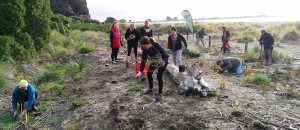
Council-community partnership projects have proven a successful formula for restoring coastal margins. Photo: Shane Orchard
Based on an article by Shane Orchard, University of Canterbury.
The design of shoreline protection initiatives is a cornerstone topic in the discourse on coastal climate change. Projects to restore degraded coastal margins are an important aspect of this field, and looking ahead, the avoidance of similar degradation issues is an important topic for planning.
In recent years, there has been considerable progress achieved in many parts of New Zealand in relation to degraded dune ecosystems, and with an increasing focus on estuaries. Many of these projects are referred to as Coastcare initiatives and are often led by, or have benefited from, local community-based approaches. As such, they are an important area of activity within the wider opportunities for local community input into coastal management.
Dune conservation provides a range of benefits for people that may include protection from inundation and short-term erosion events, and risk-reduction benefits in larger magnitude natural disasters. These benefits have not escaped the attention of coastal communities, most notably where dune ecosystems occur seaward of populated areas and provide a tangible barrier to tsunami, storm surge and related periodic events. Such benefits may be reflected in coastal inundation assessments and the like, as was the case recently in Christchurch. In the absence of dunes, equivalent coastal protection in these locations would require extensive lengths of seawall or other physical structures. Additionally, the conservation of indigenous dune ecosystems is an urgent biodiversity issue. Communities also derive considerable benefits from indigenous dune biodiversity that encompass cultural values, natural character and landscape values, to name a few.
As we move towards more specific actions for climate change adaptation, engagement with coastal communities will be increasingly important and there is a need to consider the issues and opportunities for locally driven initiatives. These activities will have a direct bearing on the perception and thus adoption of effective solutions for coastal management issues. Intuitively, Coastcare-style initiatives may be a useful component of climate change adaptation, especially where a greater degree of coastal protection is afforded through activities such as dune rebuilding. The sites involved, however, may also be adversely affected by climate change, with the impacts of sea-level rise being of particular concern.
Despite offering benefits in periodic events, dunes are susceptible to longer-term erosion trends, including the shoreline retreat processes associated with sea-level rise. Impacts on dunes may be especially pronounced where attributes important to their persistence are affected, such as the maintenance of dune vegetation. Understanding the effects of climate change on projects seeking to restore and protect coastal ecosystems is therefore important, along with possible actions. Conversely, the potential contribution of natural ecosystems to achieving wider climate change adaptation goals is a related and useful topic. Both are important aspects of planning for climate change.
This blog article describes a preliminary exploration of these issues gained by seeking climate change perspectives from representatives of Coastcare groups in three parts of New Zealand. For each group a case study was prepared based on semi-structured phone interviews and document analysis in relation to four questions as follows:
- What are the key objectives in your group’s project?
- What are motivations and drivers behind these objectives?
- How has the project changed your coastal community to date, particularly in relation to climate change?
- Has climate change influenced your objectives and activities to date, and how might it influence them in the future?
Some of the important unknowns at the outset were the degree to which Coastcare objectives incorporate climate change, if at all, and whether specific steps have been taken to address issues and opportunities related to sea-level rise in the context of these projects. A summary of each case study will be presented in the series of blogs to follow.



